Bangalore Aviation has produced a set of graphics which provide significant insight in the domestic operating performance of Indian carriers for the last 12 months. The source data is obtained from India’s regulator The Directorate General of Civil Aviation.
On time performance
One of the key selling points of IndiGo, India’s largest domestic airline, is, on time performance (OTP). As the graphic below shows, IndiGo has performed to its promise, and consistently led the industry on this key metric. National carrier Air India was the consistent laggard.
The graphic highlights the dominance of New Delhi in the airline network. The airport is the largest in India and home to four airlines. Air India, IndiGo, SpiceJet and Vistara, the Tata-Singapore Airlines joint venture. Come the winter fog season from December to February, and schedules of all the airlines head south, and have a cascading effect through the airlines’ networks.
The OTP of low fare carrier SpiceJet is reflective of the financial problems that hit the airline through the latter half of last year. In subsequent graphics you will also observe the impact on flight cancellations and passenger complaints for the Gurgaon head-quartered airline.
Surprisingly the DGCA did not report OTP of AirAsia India which has been operating for almost a year and for Air Costa which has been operating for much longer. The declining performance at Air Costa again reflecting the financial problems that hit the airline recently.
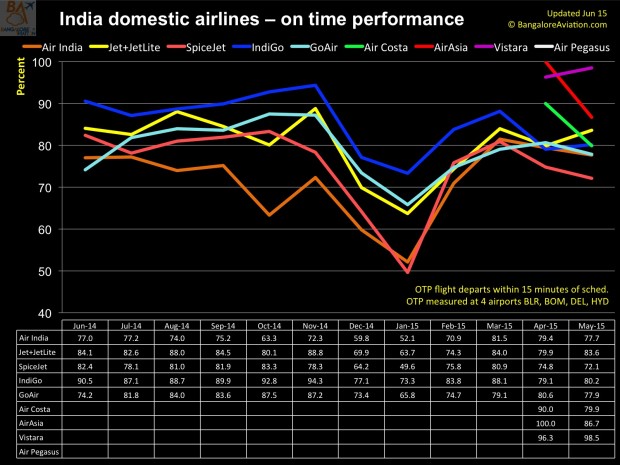
Flight cancellation rate
The graphic shows the percent of flights cancelled per month. The spike in the winter is as a direct effect of the notorious fog of New Delhi. However, the erratic performance of Air Costa, and SpiceJet reflect their financial troubles. SpiceJet topped the charts with almost 33% of its flights cancelled in December 2014. Air Costa has been going all over the charts. AirAsia India too had a torrid winter, but it was more due to HR issues than weather.
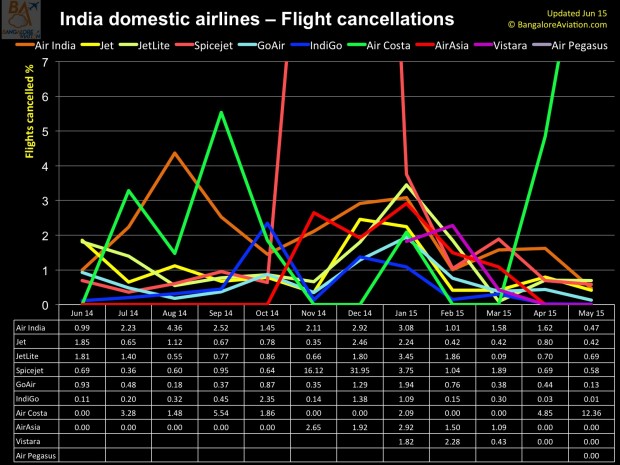
Passenger complaint rate
The service levels and therefore complaint levels have been largely consistent through the last year. Complaints peak when flights are delayed or cancelled. A reflection of the toothless CAR (civil aviation requirement) instituted by the government which essentially forgives airlines for any and all mistakes.
Curiously, GoAir has been having a very erratic year. SpiceJet’s complaints peaked with its cancellations. AirAsia India began its operations horribly, got its act together, but again seems to have declined somewhat.
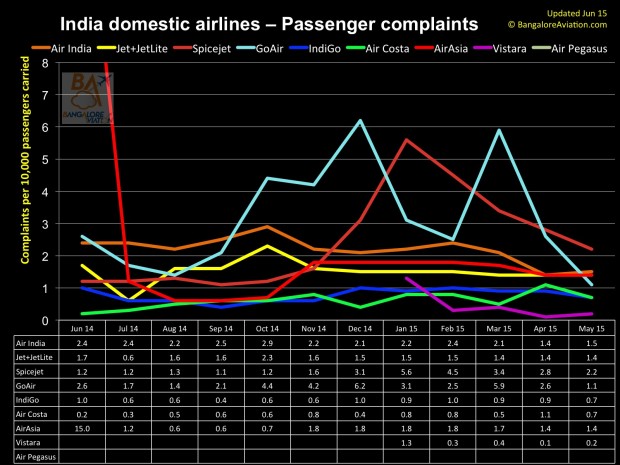
Passengers carried
The year shows the role of the summer holidays which occur from May to June in the south and May to July in the north of the country. Similarly traffic peaks during the Dussera and Diwali holidays, as well as in December when there is significant expat and overseas Indian movement.
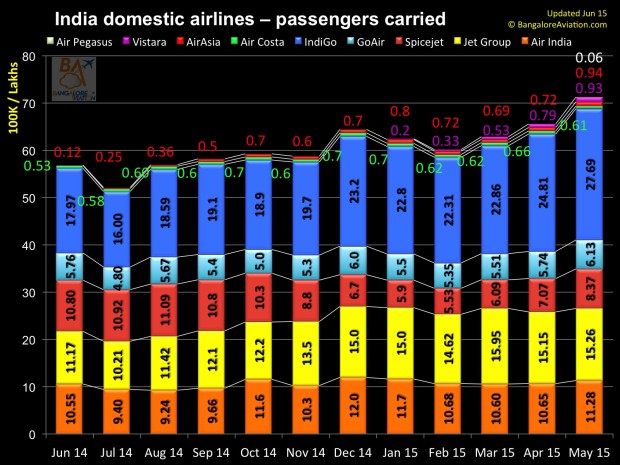
Market share
A year ago both SpiceJet and GoAir were sitting pretty. Then came the financial implosion of SpiceJet and its market share collapsed. GoAir faced a leadership crisis and it too saw market share erosion. After a brief dalliance with other airlines, passengers returned back to the familiar arms of IndiGo giving the airline a whopping 39% of market share. The year also saw a resurgent Jet Airways group clawing back market share, especially in the full service segment from national carrier Air India.
Alarm bells must be ringing in both Kuala Lumpur and Bangalore that AirAsia India holds a miserly one per cent of market share after close to one full year of operations. India is proving a tough nut to crack for one of the largest low cost airlines in the world.
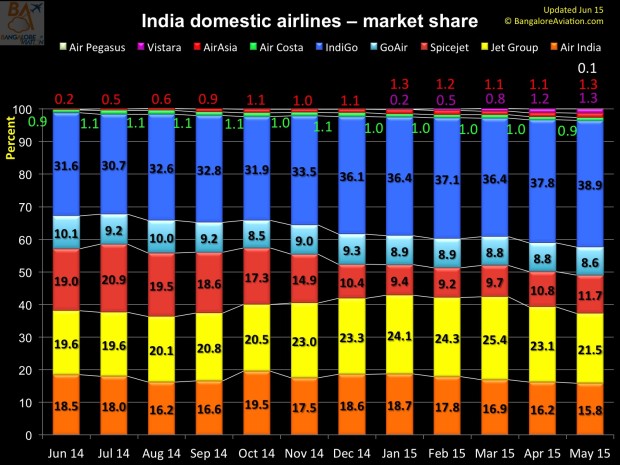
Passenger load factors
Indian airlines are keeping their planes filled using all types of techniques. Despite its financial troubles, SpiceJet has been above 80% passenger load factors (PLF) for the last 12 months. IndiGo and GoAir which lagged in the 70’s 12 months ago, powered up as SpiceJet’s financial troubles hit. AirAsia India remaining in the 70’s would most definitely be a cause for concern at the airline. Vistara is showing healthy growth as its operations pick-up. Jet Airways group started slow, powered up in the winter and summer holidays but has strangely slowed down again.
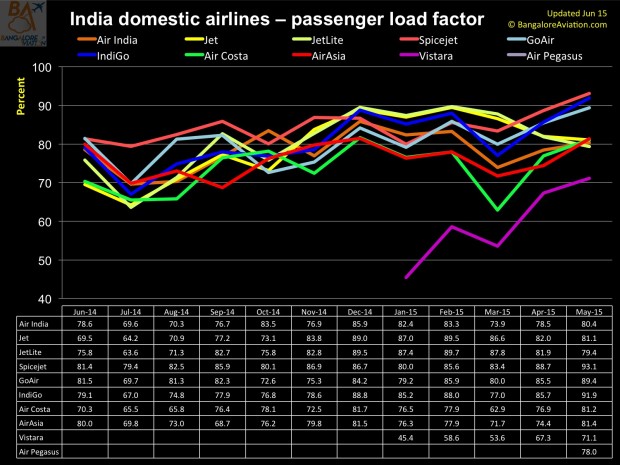
Your comments and thoughts
Bangalore Aviation has the honour of having many aviation enthusiasts, and knowledgeable readers. Do share your thoughts on your opinions and analysis on the performance numbers.
 Bangalore Aviation News, Reviews, Analysis and opinions of Indian Aviation
Bangalore Aviation News, Reviews, Analysis and opinions of Indian Aviation
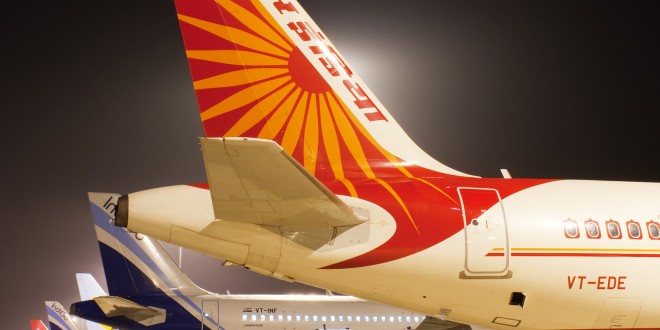




One comment
Pingback: Vistara refutes media reports on possible winter fog grounding - Bangalore Aviation